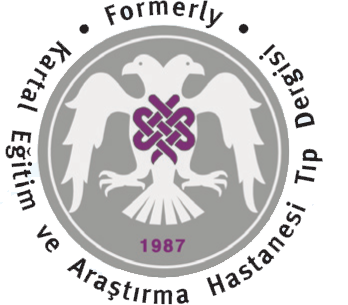Volume: 22 Issue: 1 - 2011
| RESEARCH ARTICLE | |
| 1. | Comparison of the remifentanil and remifentanil+propofol combination for sedoanalgesia in functional endoscopic sinus surgery Hatice Gül Sarıkaya, Emine Dinçer, Asu Özgültekin, Güldem Turan, Filiz Turan doi: 10.5505/jkartaltr.2011.95914 Pages 1 - 6 OBJECTIVE: We aimed to compare the remifentanil and remifentanil + propofol combination for sedoanalgesia in functional endoscopic sinus surgery performed under local anesthesia. METHODS: Forty patients from American Society of Anesthesiologists (ASA) I-II patients between the ages of 18-70 years were divided randomly into two groups. The 1st group (n=20) received 1 mcg/kg remifentanil bolus and 0.1 mcg/kg/min infusion and the 2nd group (n=20) received 0.5 mcg/kg remifentanil bolus, 0.05 mcg/kg/min infusion and 50 mcg/kg/min propofol. Systolic, diastolic, mean arterial pressure, heart rate, respiratory rate, and SpO2 values, discomfort scores, verbal response to pain, OAA/S (Observers Assessment Alertness/Sedation) scale, Aldrete recovery scores, and side effects were recorded at particular intervals. RESULTS: There was no difference between groups hemodynamically. The doses used in each group showed adequate levels of sedation. 0.1 mcg/kg/min remifentanil provided better analgesia; however, the respiratory rate was reduced and nausea and vomiting were increased. CONCLUSION: We believe that either remifentanil or remifentanil + propofol combination can be used safely during functional endoscopic sinus surgery operations for sedoanalgesia in monitored anesthetic care at determined dose intervals. |
| 2. | Evaluation of patients admitted to the emergency department with fever and convulsion with respect to lumbar puncture and laboratory findings Dilek Sumengen, İbrahim Silfeler, Bayram Ali Dorum, Yekta Canbak, Hilal Kurnaz, Fugen Pekun, Asiye Nuhoglu doi: 10.5505/jkartaltr.2011.53215 Pages 7 - 14 OBJECTIVE: Febrile seizure in children is the most common type of convulsion and is observed in children between the ages of 6 months to 6 years. The pathology of febrile seizures is still not fully explicated, but the existence of a genetic predisposition is well known. We aimed to examine when and under what conditions lumbar puncture needs to be implemented in patients who have experienced fever and convulsion. METHODS: To this end, we evaluated the clinical and laboratory results of 199 children with fever and convulsion between the ages of 6 months to 6 years. RESULTS: The most common cause of fever in patients with febrile convulsions was upper respiratory tract infection. Our laboratory findings revealed that the regularly determined C-reactive protein levels were not significant for any age group. CONCLUSION: For patients younger than 12 months, white blood cell levels can help, but alone are not sufficient for the diagnosis or lumbar puncture. As a result, we suggest that routine lumbar puncture should be implemented in accordance with the recommendations of the American Academy of Pediatrics regardless of the clinical and laboratory findings, especially in patients under the age of 1 year with febrile convulsions. |
| 3. | Our otoplasty results with suture-only techniques Şaban Çelebi, Öner Çelik, Çiğdem Tepe Karaca doi: 10.5505/jkartaltr.2011.27167 Pages 15 - 19 OBJECTIVE: The human auricles are important parts of the aesthetic facial units. Many techniques have been published for correcting and reducing the complication rates of prominent ear. The present report aims to report our experience and results with suture-only otoplasty techniques. METHODS: Seventeen patients with 33 prominent ears were treated with Mustarde and conchomastoid suture techniques. Under general anesthesia, all patients were operated without cartilage incision, excision, abrasion, or scoring. After the antihelix was composed, the conchomastoid suture was tied and then the excessive skin excised. A tight dressing was applied. RESULTS: Complications of the operations included hematoma in one ear as the major complication (3.3%) and asymmetric ear as the other (3.3%). All patients were satisfied with the results (100%). CONCLUSION: The suture-only technique is a safe and simple technique that may be an alternative to the other techniques that involve abrasion, incision and/or tubing. |
| 4. | Comparison of intratympanic steroid treatment versus hemodilution and vasoactive treatment combination in sudden hearing loss Sedat Aydın, Arif Şanlı, Gökhan Altın, Mehmet Eken, Süleyman Hilmi Yılmaz doi: 10.5505/jkartaltr.2011.18199 Pages 20 - 24 OBJECTIVE: Sudden hearing loss may be defined as sensorineural hearing loss of at least 30 dB of 3 or more frequencies emerged in the last 3 days. The purpose of this study was to compare the hearing outcomes of intratympanic steroid treatment and hemodilution and vasoactive treatment combination. METHODS: In this prospective study, 49 consecutive patients with idiopathic sensorineural hearing loss treated between 2005 and 2010 were enrolled. Twenty-five were in the intratympanic steroid group and 24 were in the hemodilution and vasoactive treatment combination group. In the intratympanic steroid group, 5 intratympanic injections of methylprednisolone were performed with the dose of 20 mg/ml. In the combination group, intravenous dextran and oral pentoxifylline were given as the primary therapy. The pure tone averages were analyzed statistically in each group after the treatment. RESULTS: The improvement in pure tone average after treatment was 32.22 dB in the intratympanic steroid group and 22.13 dB in the combination group. The intratympanic steroid therapy patients had better hearing recovery than patients in the combination treatment group (p<0.05). CONCLUSION: Intratympanic steroids produced better hearing results than combination (hemodilution and vasoactive) therapy, with no steroid side effects. Studies with larger sample sizes will identify the best steroid for injection, application time, frequency, and dose. |
| CASE REPORT | |
| 5. | An unusual presenting symptom in pulmonary embolism: Hiccup Elif Torun, Nagihan Durmuş doi: 10.5505/jkartaltr.2011.55376 Pages 25 - 28 Hiccup is an annoying condition and has no known physiological function. When persistent, hiccups may indicate a disorder. We present a case of pulmonary embolism presented with long-lasting hiccup. A 71-year-old male patient complaining of hiccup lasting for 14 days applied to another healthcare facility and received chlorpromazine and antibiotics. The complaints persisted and he applied to our hospital. On chest-X-ray, elevated right diaphragm, blunted right costophrenic sinus and linear atelectases in the right lung were detected. Venous Doppler ultrasonography of the lower extremities revealed acute thrombi. Thoracic computerized tomography angiography showed thrombi in the superior vena cava, azygos vein and lower branches of the right pulmonary artery. To our knowledge, hiccup was not reported to be a symptom of pulmonary embolism, and this is the first case presenting with hiccup. The most important point in treatment is exclusion of an underlying disease. Patients with chronic hiccup should be carefully examined for an underlying disorder. |
| 6. | Non-Hodgkin lymphoma in the orbita: A case report and review of the literature Alpaslan Mayadağlı, Mihriban Koçak, Zedef Özdemir, Kemal Ekici, Naciye Özşeker, Atınç Aksu doi: 10.5505/jkartaltr.2011.49368 Pages 29 - 34 Primary malignant lymphomas account for 10% of orbital tumors. Most orbital lymphomas are non-Hodgkin lymphomas. Patients are usually in their sixth or seventh decade. Orbital lymphoma is seen bilaterally in 10-15% of cases. Radiation therapy is the first treatment in these cases. In this study, the efficacy and importance of stereotactic radiotherapy for orbital involvement are discussed. |
| 7. | Primary abdominal pregnancy: A case report Dilek Benk Şilfeler, Arif Güngören, Kenan Dolapçıoğlu, Atilla Karateke, Çağatay Güney, Mehmet Mustafa Akın, Ali Ulvi Hakverdi, Ali Baloğlu doi: 10.5505/jkartaltr.2011.63497 Pages 35 - 37 Primary abdominal pregnancy comprises only 1% of all ectopic pregnancies. In abdominal pregnancies, the gestational sac is usually implanted in the pelvis or liver and vascular regions as high as the mesentery. It is the major cause of maternal morbidity and mortality. The potential mortality can be reduced seriously with early diagnosis and treatment. The diagnosis is confirmed using the abdominal criteria of Studdiford. In the early weeks of pregnancy in cases suitable for treatment, results in the laparoscopic surgery group were excellent. In the absence of surgery, systemic or local methotrexate treatment gives very good results. |
| 8. | Acut appendicitis as first sign of colon cancer in young patients Necmi Kurt, Hasan Ediz Sıkar, Cemile Kurt, Mehmet Eser, Hüseyin Uzun, Salim Balin, Selçuk Göktaş, Mehmet Gökçeimam doi: 10.5505/jkartaltr.2011.57070 Pages 38 - 41 Acute appendicitis occurs with obliteration of the appendix lumen due to fecaloma, lymphoid hyperplasia, parasite, foreign body, and tumor. In recent years, it has been reported that obstruction by colon tumors also creates signs of appendicitis, based upon which the appendicectomy operation is done. Knowing that it can be seen in patients over the age of 40 who underwent appendicectomy operation, the necessary investigations for diagnosis should be conducted during preoperative, perioperative and even postoperative period. We aimed to emphasize the relation between acute appendicitis and colon cancer among young patients by introducing two patients under 40 years who were diagnosed with appendicitis, and underwent appendicectomy operation; however, they were later diagnosed with colon cancer. |
| 9. | Pseudo Bartter syndrome: A case report Mesut Okur, Ayşenur Otlu, Dursun Ali Şenses doi: 10.5505/jkartaltr.2011.42650 Pages 42 - 44 A 7.5-month-old girl was brought to our emergency department with the complaint of pulmonary infection for 2 days. Pseudo Bartter syndrome was diagnosed in this patient with hyponatremia, hypokalemia, hypochloremia, and metabolic alkalosis during follow-up in the intensive care unit. The patients general condition, electrolyte imbalance and alkalosis improved with intravenous fluid treatment and appropriate deficit therapy. The patient was followed subsequently with cystic fibrosis based on sweat test result of 120 mEq/L. |
| 10. | Follow-up and treatment of a severe tetanus case in the intensive care unit Tamer Kuzucuoğlu, İlker İtal, İzzet Alatlı doi: 10.5505/jkartaltr.2011.86547 Pages 45 - 48 Tetanus is an acutely progressive, morbid disease that results from exposure to the exotoxins produced by Clostridium tetani. The disease has an importance because of its high mortality, especially in patients older than 60 years. Respiratory failure is the most severe problem related to generalized tetanus. Mechanical ventilation is almost always mandatory for the therapy of respiratory insufficiency in patients with tetanus-developed airway obstruction. The patient presented herein was 65 years old and nonimmunized, and had generalized tetanus and respiratory failure. She was transported to intensive care unit following intubation. Mechanical ventilation was applied for 27 days to relieve autonomic dysfunction. Midazolam and magnesium were given for sedation, and when sedation was insufficient, neuromuscular block was administered. She was discharged at 38 days when respiratory and cardiac functions and hemodynamic parameters had resolved. In this report, we aimed to present the follow-up and treatment of a patient with severe tetanus in intensive care unit. |
| REVIEW | |
| 11. | Management of metastatic bone tumors Alpaslan Mayadağlı, Güven Bulut, Kemal Ekici doi: 10.5505/jkartaltr.2011.82787 Pages 49 - 55 Abstract | |



















